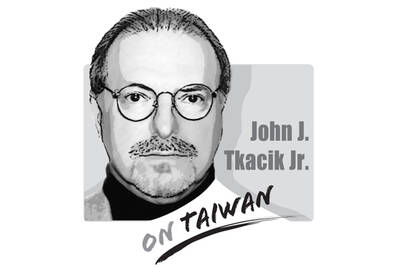The central bank on Thursday surprised the market by announcing to raise its three benchmark interest rates by 12.5 basis points, effective Friday. Prior to Thursday, the central bank had cut interest rates by a total of 237.5 basis points since September 2008, and most economists had forecast the bank would not raise rates until later this year or early next year.
So, what was the main reason prompting the central bank to make its first rate move since February last year? Based on the bank’s press statement and what central bank governor Perng Fai-nan (彭淮南) said on Thursday, it was aiming to gradually bring market rates up to “normal levels” after it halted quantitative easing measures in March, because it was concerned about negative “real” interest rates — when the nominal interest rates are lower than the inflation rate.
Therefore, as expected, the central bank on Friday raised the interest rates on its daily offerings of negotiable certificates of deposit by six basis points in order to bring down the level of excess funds in the market. Several state-run banks have also decided to follow the central bank’s move and are hiking their savings and deposit rates by between 0.01 percentage points and 0.125 percentage points, effective tomorrow.
Apart from raising interest rates at a time when the nation’s economy is recovering and unemployment is decreasing, the central bank also announced on Thursday several credit-tightening measures to curb property speculation in the greater Taipei area.
For instance, the central bank decided to impose a 70 percent cap on all banks’ loan-to-value ratios to mortgage applicants when buying second houses in Taipei City and 10 cities in Taipei County and remove grace periods for those applicants’ loan repayments.
The central bank has taken some other measures since October last year to curb speculation in the local housing market and the latest move was consistent with its policy of cooling the property market down in major cities, but the targeted credit-tightening measures on mortgage loans this time is the bank’s first such move in two decades.
Indeed, a rate hike of only 12.5 basis points demonstrated the central bank was leaving itself a certain flexibility. It also suggested the bank is confident in Taiwan’s export-oriented economy and willing to raise interest rates without too much concern about Europe’s debt crisis and others’ external problems.
However, a small margin like that, coupled with the targeted credit-tightening on mortgage loans, implies the bank was making acting pre-emptively to cool property prices in the big cities, believing it had to take real action rather than relying on moral persuasion.
The central bank’s latest move may signal the beginning of a cycle of rate hikes and credit-tightening measures in this country. Whether property prices in major cities will start falling, however, remains to be seen.
Most importantly, the government should not let the central bank be alone in battling the looming threat of housing bubbles. Other agencies must move faster and act efficiently to deal with rampant property speculation and opaque real estate information. After all, this issue is certain to gain even more attention as housing affordability becomes a hot topic ahead of the special municipality elections in November and the presidential election in 2012.
Before 1945, the most widely spoken language in Taiwan was Tai-gi (also known as Taiwanese, Taiwanese Hokkien or Hoklo). However, due to almost a century of language repression policies, many Taiwanese believe that Tai-gi is at risk of disappearing. To understand this crisis, I interviewed academics and activists about Taiwan’s history of language repression, the major challenges of revitalizing Tai-gi and their policy recommendations. Although Taiwanese were pressured to speak Japanese when Taiwan became a Japanese colony in 1895, most managed to keep their heritage languages alive in their homes. However, starting in 1949, when the Chinese Nationalist Party (KMT) enacted martial law
Chinese agents often target Taiwanese officials who are motivated by financial gain rather than ideology, while people who are found guilty of spying face lenient punishments in Taiwan, a researcher said on Tuesday. While the law says that foreign agents can be sentenced to death, people who are convicted of spying for Beijing often serve less than nine months in prison because Taiwan does not formally recognize China as a foreign nation, Institute for National Defense and Security Research fellow Su Tzu-yun (蘇紫雲) said. Many officials and military personnel sell information to China believing it to be of little value, unaware that

“Si ambulat loquitur tetrissitatque sicut anas, anas est” is, in customary international law, the three-part test of anatine ambulation, articulation and tetrissitation. And it is essential to Taiwan’s existence. Apocryphally, it can be traced as far back as Suetonius (蘇埃托尼烏斯) in late first-century Rome. Alas, Suetonius was only talking about ducks (anas). But this self-evident principle was codified as a four-part test at the Montevideo Convention in 1934, to which the United States is a party. Article One: “The state as a person of international law should possess the following qualifications: a) a permanent population; b) a defined territory; c) government;
The central bank and the US Department of the Treasury on Friday issued a joint statement that both sides agreed to avoid currency manipulation and the use of exchange rates to gain a competitive advantage, and would only intervene in foreign-exchange markets to combat excess volatility and disorderly movements. The central bank also agreed to disclose its foreign-exchange intervention amounts quarterly rather than every six months, starting from next month. It emphasized that the joint statement is unrelated to tariff negotiations between Taipei and Washington, and that the US never requested the appreciation of the New Taiwan dollar during the